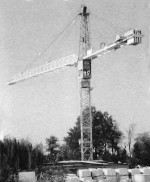Construction cranes can provide a wide variety of scientists (physiologists, ecologists, taxonomists, micrometeorologists) ready access to forest canopies, allowing more or less complete, low-impact coverage of an area up to nearly 3 hectares. Cranes are considered a breakthrough compared to older access techniques such as shooting down branches, using mountainclimbing gear and ladders, cherry picking machinery or balloons. The vertical section can also be instrumented as a research tower for measuring atmospheric/canopy exchanges by micrometeorological/vertical profile methods.
The largest standard crane extends 280 feet with a load bearing point of 270 feet from the ground, a turning radius of 245 feet and a load capacity of 6,660 pounds (a little over 3 tons). Initial costs would vary from $200,000 to $1 million, depending upon the size needed for the forest stature at a given site. Part of this cost would be for designing and building a suitable suspended ‘pod’ for equipment and people to work from. Potential drawbacks include the environmental effects of installation, the high costs of skilled operation and maintenance, and the cost and difficulty of moving such large machinery to other locations.
The Smithsonian Institution is currently raising funds to purchase a 50- to 60-meter tall crane for its Environmental Research Center site at Edgewater, Maryland, and its Tropical Research Institute site in Panama.
For further information, contact David L. Correll, Director, Smithsonian Environmental Research Center, P.O. Box 28, Edgewater MD 21037-0028.

 Enlarge this image
Enlarge this image